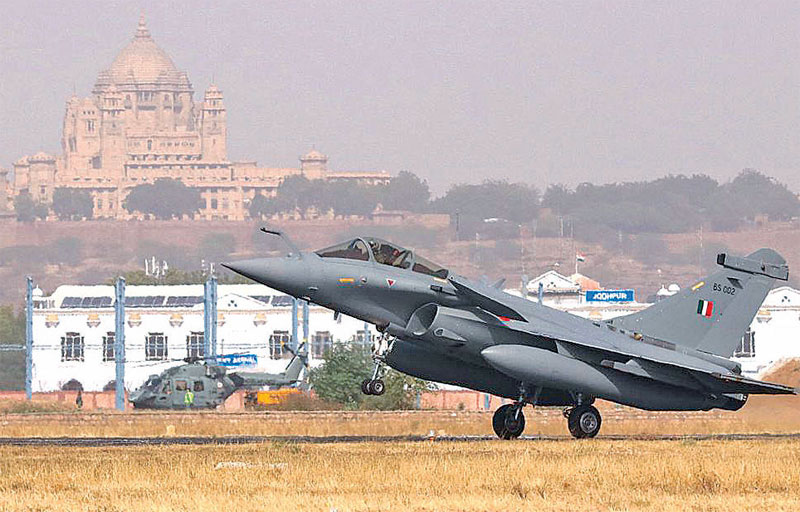An overview of the IAF exercises reflects the foreign policy priorities of the government
Smruti D
The Indian Air Force carried out multiple joint exercises with other air forces throughout the year. Apart from achieving operational preparedness and boosting interoperability, strategic outreach with friendly foreign countries is one of the most important objectives behind conducting these exercises.

Bilateral or multilateral exercises help the forces get familiar with not only different military platforms used by the other forces but also their basic operational concepts. Consequently, these exercises help develop readiness and learn new tactics from one another. This year, the IAF exercises focussed on objectives ranging from Humanitarian Assistance and Disaster Relief (HADR) operations to undertaking simulated air combat operations.
Multilateral Exercises
In March this year, the IAF participated in a multilateral exercise the Desert Flag VI, which was hosted by the United Arab Emirates. This exercise was the first annual multinational exercise hosted by the UAE.
The IAF participated in this exercise with six Su-30MKI fighters, two C-17 heavy lift aircraft and one IL-78 tanker aircraft. The C-17 Globemaster provided support for induction/ de-induction of the IAF contingent. The Su-30MKI aircraft undertook long range ferry, routing direct from India to the exercise area with aerial refuelling support from IL-78 tanker.
The air forces of the United States, France, Saudi Arabia, South Korea and Bahrain also participated in the exercise that was held at Al-Dhafra airbase. A press statement from the ministry of defence, ahead of the exercises stated, ‘Exercising and interaction with the participating nations in a dynamic and realistic warfare environment will also contribute to strengthen international relations.’
In 2017, Israel too had hosted a multinational air force exercise wherein different countries’ air forces participated. The IAF too was a part of it. The exercise, named Blue Flag is a bi-annual multilateral exercise which aims to strengthen military cooperation among participating nations.
A 45-member strong contingent of the IAF took part in the exercise. The purpose of the exercise was to strengthen military cooperation amongst participating nations. It was first held in 2013, which included several foreign country air forces. In 2017, the participants included the United States, Poland, Italy and Greece along with India, France and Germany participating for the first time. The goal of the Blue Flag training exercise was to simulate extreme combat scenarios and coalition flights as realistically as possible.
Exercise Red Flag held by the United States Air Force (USAF) aims at realistic air-combat training for military pilots and other flight crew members from the United States and allied countries. The exercise is held multiple times a year between the air forces of countries that the US considers its friends or allies. Even as the exercise was first held in 1975 between the aircrews of the United States Air Force (USAF), United States Navy (USN), United States Marine Corps (USMC), United States Army (USA) and numerous NATO and allied nations’ air forces, India only became a part of the exercise in 2008, when it was held at Nevada.
However, the IAF had made it clear that it won’t be a part of the exercise in every edition due to the high expense it incurs. That year, India sent eight Su-30MKIs of the elite 20 Squadron, along with two IL 78 mid-air tankers and one IL 76 heavy lift aircraft along with 91 officers and 156 other ranks. The contingent covered a distance of 19,000 km after starting from Pune on July 7 to reach Mt Home Air Base 10 days later.
It left the US territory on August 25, taking off from the Nellis Air Force Base, and returned to India through UAE, where it did four days of mutually beneficial aerial exercises with the UAE Air Force’s six squadrons of F-16 and Mirage 2009 aircraft. What was special about these exercises was that the Su-30MKI aircraft went to the US for the first time. However, the IAF did not disclose the capabilities of the Sukhoi entirely as India was bound not to reveal certain technical details of the aircraft to the US. It was after eight years that the IAF participated in the Red Flag exercise again. The IAF flew to Alaska. IAF deployed Su-30MKI aircraft and Jaguars DARIN II for offensive counter-air operations and integrated strike missions respectively.
The online portal, Air Force Technology stated, “The Indian Air Force (IAF), the US Air Force (USAF) and the US Navy (USN) successfully completed an advanced aerial combat training exercise, Red Flag Alaska 16-1, at Eielson Air Force Base, in the US state of Alaska. RED FLAG-Alaska was a series of Pacific Air Forces commander-directed field training exercises for the US forces to provide joint offensive counter-air, interdiction, close air support, and large force employment training in a simulated combat environment.”
You must be logged in to view this content.

